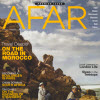If your site uses a conventional, easily recognized visual scheme for text links—and it should—the words making up every link will stand out conspicuously. Highlighted in a distinctive color and with an underline, text links signal to the viewer that they are more important, urgent, and interactive than the rest of the words on the page.
In other words, online links have the same power that conventional display copy has in print. Given that power, Web writers and editors should give text links special consideration.
Keep text links concise—no more than two or three words, if possible.
Text links consisting of run-on phrases or whole sentences have no “pop.” If you’re highlighting nearly everything, then you’re really highlighting nothing. There is no visual signal to engage the typical Web user’s quickly scanning eye.
Here’s an example we found on a technology site. There are so many words in each link and the links are so crammed together that nothing stands out.
Scoop: Full review of the Slingbox Pro
Nifty new tech from DemoFall 2006
Video: Veronica vs. the blingy gold Razr
Roundup: Laptops of the future, today
Review: New Canon PowerShot A710 IS
Watch out for Mac Wi-Fi hijackers
Our 2006 Paris Auto Show preview
Sirius announces the Stiletto 100 portable
Below is a quick rewrite we did that narrows down the links to two or three words. (We also added underlining, so that users aren’t forced to mouse over the words to confirm that they are indeed links. And we threw in some bullets to separate the lines a bit.) The result: strong visual hooks that are easy to spot at a glance.
- Slingbox Pro: The full review
- Nifty new tech from DemoFall 2006
- Video: Veronica vs. Razr
- Laptops of the future, today
- Camera review: New Canon PowerShot A710 IS
- Security: Watch out for Mac Wi-Fi hijackers
- Paris Auto Show preview
- Sirius announces the Stiletto 100 portable
Choose your words wisely.
In print, you wouldn’t just turn any old phrase from an article into a headline or pull-quote. You’d craft it using clear, specific, informative terms. Apply the same strategy when creating text links.
In our rewrite above, the words we isolated for our brief links are concrete, high-interest words. Nouns that line up with the audience’s hot buttons are most effective.
And if possible, include verbs that explain or evoke the interactive experience that is triggered by the link. “Click,” as in “click here,” is not the sort of verb we’re talking about.
The best text links team up evocative verbs with concrete nouns, as in:
- Ask your Congressperson to support the global fight against AIDS.
- For full step-by-step instructions, watch our video tutorial.
- Order Child Sponsorship Handbook as an Adobe Acrobat file (PDF).
- Learn about treatment options for various types of cancer.



